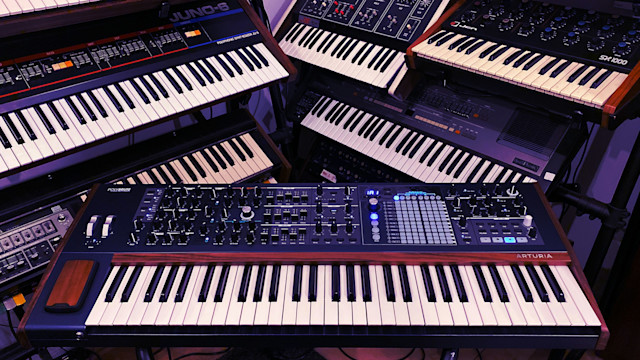An Introduction To Diminished Chords In Songwriting
August 19, 2024 - Discover the unique sound of diminished chords in songwriting. Learn how they add tension, drama, and complexity to your compositions, enhancing your musical range.

In music theory, diminished chords stand out for their distinctive and somewhat ominous sound.
A diminished chord is composed of two minor third intervals stacked on top of each other, creating a minor triad with a flattened fifth. This unique construction gives diminished chords their characteristic tension and instability, captivating musicians and listeners alike.
I've always been fascinated by the diminished chord and its unique feel. Although it's not the most common chord in pop songs, there are unique situations where it fits in really well.
When you incorporate dim chords into your chord progressions, you open the door to a whole new palette of emotions and atmospheres. They can add a dramatic flair to your compositions, serving as transitional bridges that can lead to surprising and unusual resolutions.
Understanding how to use diminished chords will definitely enhance your musical range and should be a part of your songwriting toolkit. They can function as passing chords, create chromatic interest, and add an element of unpredictability.
Pssst! If you want to create chord progressions in the simplest way possible, try Soundtrap Chords. Chords is a creation tool that lets you come up with awesome chords for any genre, without having to understand music theory or know how to play an instrument.
Understanding Diminished Chords
Diminished chords bring a distinct, often eerie quality to music, primarily through their unique interval structures.
Diminished Triads
A diminished triad consists of three notes: the lowest note, usually called the root, a minor third, and a diminished fifth. To play a diminished triad, begin with the root note, add a note three half steps (a minor third interval) above, and then a note six half steps above the root, resulting in a diminished fifth.
This structure creates a tense, unresolved, distinctive sound often used in transitional passages.
Here's an example of the notes in a C diminished triad (Cdim):
C (root)
E♭ (minor third)
G♭ (diminished fifth)
Fully Diminished 7th Chord
Fully diminished 7th chords add more complexity and tension. Apart from the root, minor third, and diminished fifth, they include a diminished seventh. The diminished seventh is a double flat, a full step below the octave of the root position.
This chord's formula is often noted as 1, ♭3, ♭5, and ♭♭7.
An example of C diminished 7th (Cdim7):
C (root)
E♭ (minor third)
G♭ (diminished fifth)
B♭♭ (diminished seventh, which sounds like A)
Half-Diminished Chords
Half-diminished chords, also known as mi7♭5, incorporate a minor seventh instead of a diminished seventh. This difference slightly reduces the tension compared to fully diminished 7th chords.
The structure includes the root note, minor 3rd, diminished 5th, and minor 7th.
The following example shows the C half-diminished (Cø7):
C (root)
E♭ (minor third)
G♭ (diminished fifth)
B♭ (minor seventh)
These harmonies are prevalent in classical and jazz music for their rich, nuanced sound.
The Role of Diminished Chords in Music
Diminished chords serve various roles in music. They provide tension and instability, making harmonic progressions more interesting. They also offer possibilities for chord substitution and extension, allowing you to add variety to your compositions.
Harmonic Function
Diminished chords create a strong sense of tension and desire for resolution. This tension arises from their unique structure, which includes a minor third and a diminished fifth. These intervals produce a dissonant sound that naturally seeks a resolution.
Passing Chord
One common use is as a passing chord with chord changes. A diminished chord can link major or minor chords, creating a smooth transition.
For example, in the chord progression C - C#dim - Dm, the C#dim acts as a bridge between C major chord and Dm.
Dominant Function
Another function is their use in dominant function. In this role, diminished chords often precede a dominant chord, enhancing the drive towards the tonic.
A great example of this is how A diminished (A, C, Eb) can lead to G in the key of C major, adding a compelling sense of movement.
Chord Substitution and Extension
Diminished chords are useful in chord substitution. They can replace or modify standard chords to add variety.
Let's take a G7 chord and how it can be substituted with a Bdim7. Both share common tones (B, D, F) but the dim7 adds more tension.
Diminished chords expand harmonic vocabulary in jazz and modern music. They can extend traditional progressions, providing new avenues for exploration.
Using G#dim7 in a C - F - G7 - C progression can replace the G7, adding a surprising twist.
You should learn to utilize diminished chords creatively to spice up your chord progressions. I'm not saying use them everywhere,
Their potential for tension, resolution, and substitution makes them an invaluable tool in your musical toolkit.
Playing Diminished Chords
Diminished chords add a unique, unsettling tension to music. Let's explore various chord shapes on the guitar and learn how these chords differ across instruments.
Chord Shapes and Positions
When playing diminished chords on the guitar, you can use several common shapes. For instance, here's an easy way to play a C diminished chord using the following positions:
A shape: X-3-4-5-4-X
G shape: 8-6-X-8-7-X
E shape: 8-9-10-8-7-X
Experiment with these shapes by moving them along the fretboard to find different diminished chords and experimenting with unique chord voicings.
For more complex voicings, you might integrate diminished 7th chords. A common A diminished 7th chord shape is played as:
A dim7: X-0-1-2-1-X
Understanding these voicings will help you incorporate diminished chords into various musical styles, providing a broader harmonic palette for your compositions and performances.
Diminished Chords in Various Musical Contexts
Before we discuss the potential use of diminished chords in songwriting for pop music, we need to examine classical and jazz first; those two genres historically use diminished chords often in major roles in their compositions.
This is actually an important piece of advice I'd like to give you overall about studying music - always study the history behind the aspect of music you'd like to learn. Knowing its history and development will give you a more thorough understanding of how to use it in your writing today.
Classical Music
In classical music, diminished chords often play a pivotal role in creating tension. Composers like Beethoven and Mozart used them to build anticipation before resolving to a more stable chord.
The diminished seventh chord, in particular, is prized for its symmetrical structure, allowing it to resolve to various key centers. This versatility makes it a favorite tool for modulating between keys.
You'll find diminished chords frequently in transition passages and dramatic moments, where their unstable nature heightens the emotional impact of the music.
Jazz Harmony
In jazz, diminished chords are indispensable for their functionality in harmony and improvisation.
Jazz musicians use diminished chords for their ability to connect major and minor chords in smooth, chromatic progressions. For example, in a typical ii-V-I progression, you might insert a diminished chord to add a layer of complexity.
Jazz guitarists frequently use diminished arpeggios and scales to solo over these chords.
Understanding the diminished scale can open up new melodic possibilities. Symbols like Dim7 or °7 are common, indicating the diminished nature of the chord, which you can spot in standard jazz notation and lead sheets.
Popular Music
Contemporary pop music leverages diminished chords for their dramatic effect. Pop artists use them to create unexpected shifts and add a unique flavor to their songwriting.
For instance, in pop and rock, a diminished chord might appear as a surprising twist, leading to a chorus or a bridge.
Diminished chords lend a darker, more intense character to genres like blues and metal. The tritone interval within the chord, sometimes called "Diabolus in musica" or the "devil in music," brings a sinister edge that fits well with the emotional intensity of these genres.
Whether adding complexity to a ballad or giving an edge to a rock anthem, diminished chords have a versatile presence in modern music.

Common Progressions and Techniques
Diminished chords often serve as transitional elements in various harmonic contexts.
In a major key, the common progression involves moving from a diminished chord to a diatonic chord, such as vii° to I as expressed with roman numerals.
In minor keys, you might frequently encounter the progression from ii° to V.
Another effective technique is using diminished chords to replace dominant chords. For example, in the key of C major, B diminished (B°) can substitute for G7 due to their shared notes. Similarly, you can slide diminished chords chromatically to create tension and release.
To enrich your chord progressions, try using diminished chords to connect chords separated by intervals of a major second or minor third. This adds smoothness and intrigue.
Practice these movements by playing scales and recognizing where diminished chords can add color within different contexts.
Practice and Application
I recommend you practice regularly using diminished chords so you can use them fluidly. Start by playing basic triads and gradually introduce them into common progressions. Focus on transitioning smoothly between diminished and diatonic chords.
A great practical exercise you can do is to take a familiar song and substitute appropriate chords with their diminished counterparts. This helps you hear and internalize their unique sound. You should use a metronome to maintain rhythm and accuracy.
Additionally, experiment with diminished chords across various keys. Practice in both major and minor contexts to become versatile. Record yourself playing and listen back to identify areas of improvement.
This kind of iterative practice and mindful application will deepen your harmonic understanding and refine your ability to use diminished chords creatively.
Conclusion
I know this is a lot to take in! But trust me, incorporating diminished chords into your songwriting can give you new harmonic tools for your musical composition process. They offer a palette of emotions and atmospheres that can add new depth and different ways of expressing your ideas.
Understanding diminished chords will also expand your music theory knowledge, which in turn will help in your writing.
The unique construction of diminished chords, characterized by minor third intervals and a flattened fifth, brings a distinctive tension and dramatic flair to compositions.
I highly recommend you study and experiment with diminished triads, fully diminished 7th chords, and half-diminished chords to enhance your musical expression and create more compelling and unpredictable progressions.
Make diminished chords a staple in your toolkit to unlock new creative possibilities.
About the author
Tero Potila is a professional music composer and producer. His career combining knowledge and experience from music, TV, film, ad, and game industries gives him a unique perspective that he shares through posts on teropotila.com.
Get started with Soundtrap today!